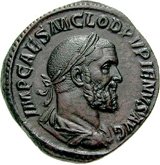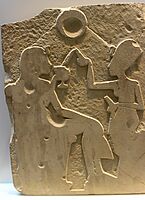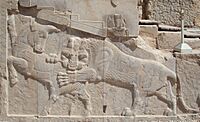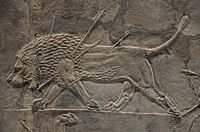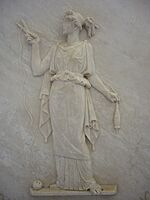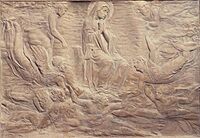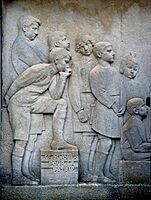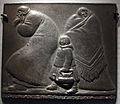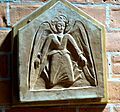Relief facts for kids
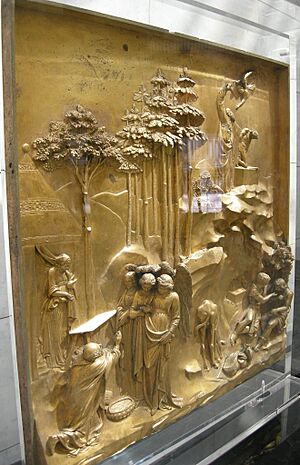
Relief is a special way of making sculpture. In relief sculpture, the carved parts stay attached to a solid flat background. Imagine a picture that pops out from a wall! The word "relief" comes from a Latin word, relevare, which means "to raise" or "to lift back".
When artists create a relief, it looks like the sculpted parts have been lifted up from the flat surface behind them. If they are carving into stone or wood, they actually cut away the background. This makes the parts that are not cut away look higher. This takes a lot of work and time!
However, making a relief has some advantages. The artist doesn't need to sculpt the back of the object. Also, reliefs are stronger and safer than sculptures that stand freely. Free-standing sculptures, especially tall ones, can break easily, like at the ankles. Reliefs are often made from materials like metal, clay, plaster, or ceramics. With these materials, the artist can simply add material to the background to create the raised shapes. Large metal reliefs are often made by casting, where melted metal is poured into a mold.
Contents
Types of Relief Sculpture
There are different kinds of relief sculpture. They are named based on how much the sculpted parts stick out from the background. The main types are high relief, low relief, and sunk relief. Artists often mix these types in one artwork.
Low Relief (Bas-Relief)
A low relief (also called bas-relief) is a sculpture where the images stick out only a little bit from the background. Think of the pictures on coins – they are all in low relief! In the lowest reliefs, the shapes might look strange from the side. But from the front, the small differences in depth create a 3D image.
This method needs less work and is cheaper to make. Less of the background needs to be carved away, or less material needs to be added. Ancient cultures like the Egyptians and Assyrians often used low relief for their artworks. These sculptures were usually painted after they were carved. The paint helped to make the shapes clearer. Today, most of that paint has worn off.

The Ishtar Gate of Babylon, which is now in Berlin, has amazing low reliefs of large animals. These were made from molded bricks and then glazed with bright colors. Plaster was also used a lot for low reliefs, especially for decorations inside buildings.
Low relief became popular again during the Renaissance in Europe. Artists like Donatello were masters of a very shallow type of low relief called rilievo schiacciato (meaning "squashed relief"). This type of relief is so flat it almost looks like an engraving.
In later Western art, low relief was often used for smaller artworks. It was also combined with higher relief to make a scene look deeper. For example, figures in the front of a scene might be in high relief, while those in the background are in low relief. This is similar to how painters use lighter colors for things that are far away. In the 20th century, low relief became popular again for decorating buildings, especially in the Art Deco style.
-
Persian low relief in Persepolis. It shows a bull and a lion, symbols of the Earth and Sun.
-
A modern Greek low relief of Atropos cutting the thread of life.
-
Donatello's rilievo stiacciato (shallow relief) of the "Assumption of the Virgin" from the 1420s.
Mid-Relief
Mid-relief, sometimes called "half-relief" or mezzo-rilievo, is a type of relief where about half of the sculpted figure sticks out from the background. The shapes are usually a bit squashed, not fully rounded.
Mid-relief is very common in Hindu and Buddhist art from India and Southeast Asia. For example, the Ajanta Caves and Ellora Caves in India have many rock reliefs from ancient times. The 1,460 panels at the Borobudur temple in Indonesia are low to mid-reliefs. They tell stories about the life of the Buddha. Other examples include the Ramayana epic stories at Prambanan temple in Java, and the temples of Angkor in Cambodia.
High Relief

High relief (or altorilievo) is when more than half of the sculpted figure sticks out from the background. Often, parts like heads and arms are completely separated from the background. The parts of the sculpture that you see are usually shown at their full depth, unlike in low relief.
High relief uses similar styles and techniques to free-standing sculptures. If you look at a high relief of a single person, it's almost like looking at a statue from the front. Many cultures throughout history have used high relief in large sculptures and buildings.
Ancient Greek sculptures often used a very "high" version of high relief. Figures sometimes crossed over each other to show depth. The metopes of the Parthenon are good examples. High relief has remained a popular form for sculptures with figures in Western art and in Indian temple sculpture.
Roman sarcophaguses (stone coffins) often had crowded high reliefs. These were carved using drills, which allowed for many figures in one scene. These Roman reliefs greatly influenced later Western sculpture. High relief became very popular again during the Renaissance and for public monuments.
The largest high relief sculpture in the world is the Stone Mountain Confederate Memorial in Georgia, USA. It is carved 42 feet deep into the mountain!
Sunk Relief
Sunk relief is mostly found in the art of Ancient Egypt. In this technique, the image is carved into a flat surface. The figure itself is in low relief, but it's set inside a sunken area that is shaped around the image. This means the relief never rises above the original flat surface of the stone.
This method saved a lot of work because the artists didn't have to remove the entire background. Sunk relief works best in strong sunlight, as the shadows help to show the outlines and shapes clearly. The edges of the sunken area are usually sharp, forming a right angle to the surface.
This technique is also used for carving letters, like the om mani padme hum mantra, into the mani stones of Tibetan Buddhism.
Small Relief Objects
Reliefs are also found on many smaller objects. These can be made from materials like ivory, wood, or wax. You can often see reliefs in decorative arts like ceramics and metalwork.
Small bronze reliefs are often called "plaques" or plaquettes. These were popular with collectors, especially during the Renaissance. They could be set into furniture, framed, or just kept as they were.
Different techniques are used for small reliefs. For metalwork, repoussé is common. This is where a thin metal plate is shaped from behind using tools, making the image pop out. Casting is also widely used for bronze and other metals. These two methods are often used together to make reliefs faster and with more detail.
Carved ivory reliefs have been made since ancient times. Because ivory is expensive and cannot be easily reused, many old ivory reliefs have survived. In the Gothic period, carving ivory reliefs became a big luxury business in places like Paris. Artists made small diptychs (two-panel artworks) and triptychs (three-panel artworks) with detailed religious scenes. They also made everyday items like mirror cases, combs, and handles, often with lower relief designs. These ivory pieces were usually painted in bright colors.
Reliefs can also be pressed onto clay using stamps or molds. This was common for mass-produced Roman pottery called terra sigillata. Large decorative reliefs made of plaster or stucco are found in many buildings, especially in Western and Islamic architecture.
Images for kids
-
Low relief from Göbekli Tepe, around 9,000 BC, showing a bull, fox, and crane.
-
The Warka Vase from Sumer, one of the earliest narrative reliefs, around 3200–3000 BC.
-
Sunk relief from the Luxor Temple in Egypt, carved in hard granite.
-
Low to mid-relief from the 9th-century Borobudur temple.
-
A Persian mid-relief from the Qajar dynasty at Tangeh Savashi in Iran. This is a rock relief.
-
Yaxchilan Lintel 24 from the Maya site of Yaxchilan, showing a bloodletting ritual.
-
Rock relief at Naqsh-e Rostam, showing the Persian emperor Shapur I with Roman emperors.
-
The 12th-century Romanesque portal of Christ in Majesty at Moissac Abbey, mixing low and high relief.
-
Harbaville Triptych, a Byzantine ivory relief.
-
A modern high relief depicting shipbuilding in Bishopsgate, London.
-
Huge Hindu rock reliefs at Unakoti, Tripura, India.
-
Ernst Barlach, Angel of Hope, 1933, in Güstrow.
-
Henry Moore, Relief No. 1, 1959, Bronze, at the Israel Museum, Jerusalem.
-
William Henry Hudson memorial, Hyde Park, London, by Jacob Epstein.
Reliefs by Modern Artists

Many artists in modern times have also created reliefs. Some famous names include Paul Gauguin, Ernst Barlach, Pablo Picasso, Eric Gill, Jacob Epstein, and Henry Moore.
Low reliefs were often used in the 20th century on the outside of buildings. They are a great way to add decorative touches to architecture.
Famous Relief Sculptures
Here are some well-known examples of large relief sculptures:
- Ancient Egypt: Most Egyptian temples, like the Temple of Karnak.
- Assyria: Many famous examples are in the British Museum, such as the Black Obelisk of Shalmaneser III.
- Ancient Persia: Persepolis, and rock reliefs at Naqsh-e Rustam.
- Ancient Greece: The Parthenon Marbles, Bassae Frieze, and the Great Altar of Pergamon.
- Mesopotamia: The Ishtar Gate of Babylon.
- Ancient Rome: The Ara Pacis, Trajan's Column, and many triumphal arches.
- Medieval Europe: Many cathedrals and churches, like Chartres Cathedral.
- India: Sanchi, the rock-cut Elephanta Caves and Ellora Caves, and the Khajuraho temples.
- South-East Asia: Borobodur in Java, and Angkor Wat in Cambodia.
- Maya and Aztec civilizations: Glyphs and Mayan stelae.
- United States: Stone Mountain, Robert Gould Shaw Memorial in Boston, and Mount Rushmore National Memorial.
Some famous smaller-scale reliefs include:
- Ivory: Nimrud ivories, Late Antique Consular diptychs, the Byzantine Harbaville Triptych, and the Anglo-Saxon Franks Casket.
- Silver: The Warren Cup, Gundestrup cauldron, and Mildenhall Treasure.
- Gold: The Berlin Gold Hat and Panagyurishte Treasure.
- Glass: The Portland Vase and Lycurgus Cup.
See also
 In Spanish: Relieve (arte) para niños
In Spanish: Relieve (arte) para niños
- Rock relief
- Multidimensional art
- Pargetting – English exterior plaster reliefs
- Relief printing – a different concept
- Repoussé and chasing – a metalworking technique
- Dongyang wood carving - A Chinese example


